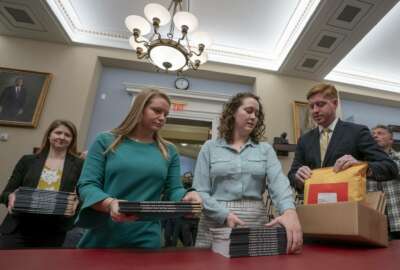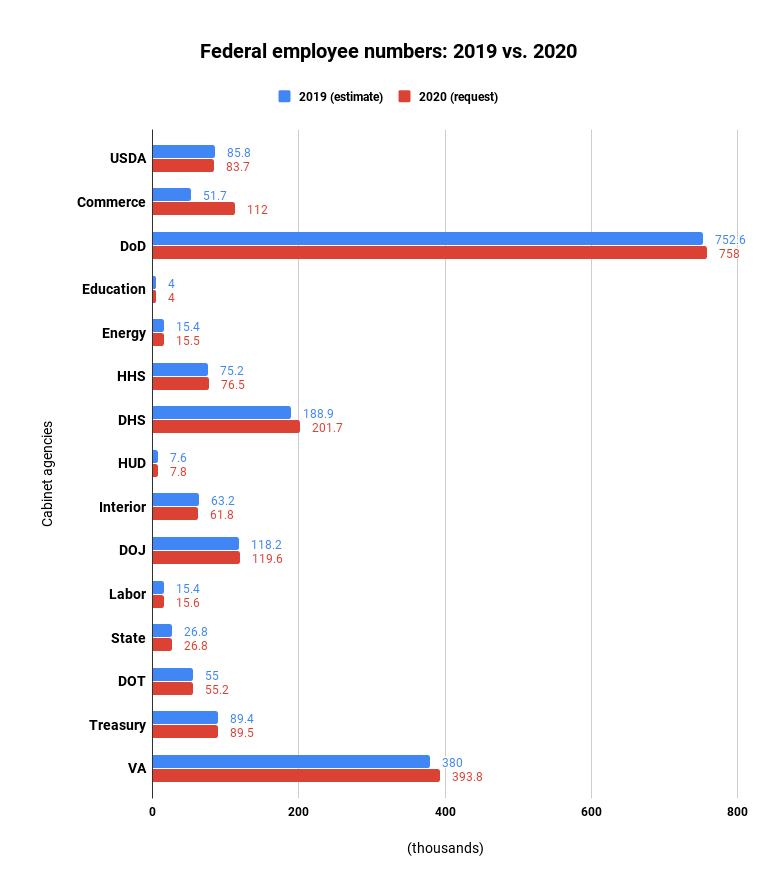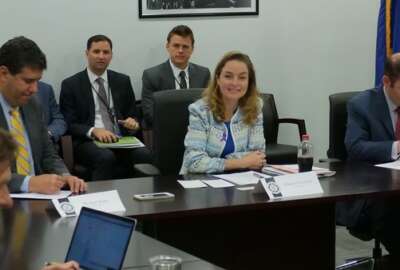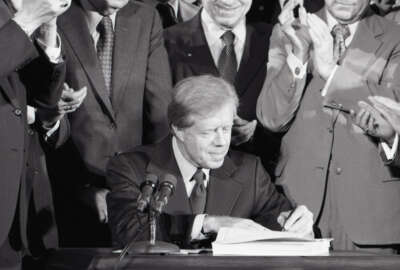
Here’s what civil service modernization looks like in Trump’s 2020 budget request
The detailed version of the President's 2020 budget request includes a series of familiar pay and retirement cuts and a wide variety of proposals designed to ch...
Best listening experience is on Chrome, Firefox or Safari. Subscribe to Federal Drive’s daily audio interviews on Apple Podcasts or PodcastOne.
2020 may just be the year the Trump administration is ready to kick the seemingly broad and ambiguous topic of “civil service modernization” into high gear.
President Donald Trump’s 2020 budget request, which the White House released with more detail Monday morning, is packed full of recommendations designed to modernize the decades-old civil service system and acknowledge the nature of changing work.
The proposals include familiar ones aimed at freezing across-the-board federal pay freezes and cutting employee retirement and health benefits. But the President’s 2020 budget request also makes a wide variety of recommendations designed to give agencies much more flexibility and authority to hire, compensate and manage employees based on their occupations, skills and specialties.
“The mission demands of the 21st century require a federal personnel system that is flexible and resilient enough to support the changing nature of work,” a section of the President’s 2020 request titled “strengthening the federal workforce” reads. “That system must have a performance orientation that enables civil servants to achieve agency missions in an effective and efficient manner while holding them accountable. Although many federal workers pursue and attain excellence, they do so despite, and not because of, the incentives built into the current system.”
Referencing the numerous studies that came from good government organizations such as the National Academy of Public Administration last year, the Trump administration reiterated its plan to pursue these recommendations through both statutory and administrative changes.
Perhaps most notably, the administration said it wants to work with Congress to “cull the approximately 5,000 statutory and regulatory rules that, over time, have created an incomprehensible, administratively burdensome and unmanageable civil service system,” the budget proposal reads.
The detailed version of the President’s request includes many of the administration’s civil service proposals. But a joint congressional budget justification from the General Services Administration and Office of Personnel Management includes many more — and reflects the administration’s desire to quickly reorganize the agency.
Federal pay freeze on the table again
As was suggested during last week’s initial 2020 budget roll out, the Trump administration is — for the second consecutive year — proposing a pay freeze for civilian federal employees. Again, the administration cited “long-term fixed costs” of across-the-board pay raises and automatic “step-increase promotions” for employees on the General Schedule as the reasons behind its proposed federal pay freeze.
“The budget proposes to slow the frequency of these step increases, while increasing the performance-based pay for workers in mission-critical areas,” the White House said. “The budget proposes that agencies use their performance awards accounts to finance more strategic workforce awards spending and innovative approaches to meet critical recruitment, retention and reskilling needs across government.”
According to the budget request, agencies spend 1 percent of their payroll today on employee awards — but in a non-strategic way. The Office of Management and Budget will issue guidance that describes how agencies can use awards funding to reward the highest-performing employees, the 2020 request said.
The 2020 budget request offers up slightly more detail than its 2019 request on the administration’s plans for performance-based pay. But it doesn’t acknowledge the role that Congress can and has played in the past in setting federal pay. Congress last month passed a 1.9 percent pay raise for civilian employees, overriding the President’s planned pay freeze.
In addition, the President’s Pay Agent, which consists of the Labor secretary and OMB and Office of Personnel Management directors, plans to establish several special occupational pay systems, as OPM suggested last fall.
The pay agent plans to solicit feedback from employing agencies, labor unions and others, publish the plans in the Federal Register and hold a few public hearings on the new, special occupational pay system, the budget request said. The pay agent will also develop new approaches for compensating employees in mission critical and emerging occupations, especially for those in STEM positions.
In addition, Trump’s 2020 budget also revives another proposal from the previous year: combining all leave into one “paid time off category. ”
Currently, federal employees receive 10 paid holidays, up to 13 sick days and anywhere from 13-to-26 vacation days, depending on tenure.
More detail on proposed federal retirement cuts
The White House on Monday offered up slightly more detail on its proposed cuts to federal retirement benefits, which it said “reflect difficult choices in light of fiscal realities.”
As last week’s 2020 budget summary described, the White House for the third consecutive year described a series of proposed cuts for both current federal employees and retirees, with the hope of saving $102 billion over the next 10 years.
- An increase in federal employee contributions by 1 percent each year,
- An elimination of the cost-of-living adjustment for current and future Federal Employee Retirement System participants and a 0.5 percent cut to the COLA for Civil Service Retirement System participants of what the typical formula currently allows,
- Reducing the interest rate for the Thrift Savings Plan’s G fund,
- Basing future retirement benefits on the average of an employee’s highest five years of salary instead of an employee’s highest three years of salary, and
- An elimination of the FERS Special Retirement Supplement, payments for employees who retire before age 62.
But Monday’s detailed budget request sheds more light on the administration’s plans to allow agencies to appoint and compensate new “term employees” with special education, experience or competency levels to address critical hiring needs.
A new focus on “term” and temporary employees
“Term employees” would receive an “expanded defined benefit contribution through the TSP,” according to the White House request. The existing federal retirement system discourages the 70,000 existing term hires, because those terms falls short of the five years it takes to become vested in the defined benefit program, the administration said.
Term employees hired under this new authority could be paid up to Executive Schedule level 2, according to a joint congressional budget justification from OPM and the General Services Administration. Term appointments would run for up to three years with the option for two one-year extensions, OPM and GSA said.
These employees would serve at the pleasure of the agency, meaning they wouldn’t face the same competitive hiring hurdles they must undergo today, and they wouldn’t have Title 5 disciplinary appeal rights.
To be clear, agencies, in some cases, already have the ability to hire employees on a temporary basis. But the Trump administration’s proposals clearly reflect a desire to expand both the number and type of term employees that agencies can hire.
And in a nod to the “21st century gig economy,” the administration also proposed new flexibility that would allow agencies to make non-competitive term and temporary appointments for up to 18 months to address any critical hiring need, the OPM/GSA budget justification said.
In addition, the administration reiterated its desire to develop an industry exchange program for STEM occupations, which would allow agencies to move talent and expertise in between government and the private sector more easily. OPM has advocated for this idea in past legislative proposals.
OPM and GSA are also advocating for the creation of a new critical skills incentive, which would allow the OPM director to pay up to 25 percent of basic pay as an additional perk to employees with high-demand skills. The proposal would also allow agencies to review, manage and revise these critical skills incentives as needed.
A new world for reskilling
The White House said it will continue to invest in reskilling existing federal employees to prepare them for a new era of work, citing recent stories with the Federal Cybersecurity Reskilling Academy.
Unlike previous years’ budget requests, the President’s proposal doesn’t make drastic cuts in the overall size of the federal workforce. In fact, OMB didn’t set target personnel levels for each agency.
The number displayed in the chart below reflect personnel estimates for both 2019 and 2020.


“Agencies will continue to examine their workforces to determine what jobs they need to accomplish their missions, in light of technological changes that automate transactional processes, artificial intelligence that can streamline compliance and regulatory processes, online and telephone chat-bots that can improve customer service and other tools that may reduce agency personnel models for mission-support positions, which may also reduce their need for full time employees,” the budget proposal reads. “Changes in federal procurement, real-estate utilization and administrative processes can also reduce personnel needs.”
Copyright © 2024 Federal News Network. All rights reserved. This website is not intended for users located within the European Economic Area.
Nicole Ogrysko is a reporter for Federal News Network focusing on the federal workforce and federal pay and benefits.
Follow @nogryskoWFED







